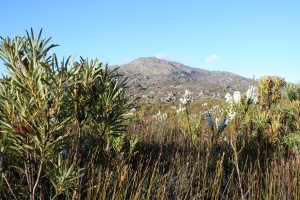“When you can measure what you are speaking about, and express it in numbers you know something about it.” Lord Kelvin
Imagine walking within any natural region of the world and being able to understand how it works: What ecological processes are unfolding? How did the surrounding species come to be there? How do so many different species coexist? What does the future hold in store for this community? How incredible would it be if we could uncover the world’s secrets. What wonders might be revealed!

Many people think that all humans share an innate biophilia: a love and appreciation of natural life. But can we extend that passion to an understanding? This question has driven biologists for centuries and has shaped my own personal experience. As a scientific realist I believe that the scientific method can make real progress in describing real features of the world. A large part of me agrees with the sentiment expressed by Lord Kelvin; that you can only really know something when you can measure it. Yet, the natural world is complex and it requires much patience and focus to unravel its secrets.
I have begun my ambitious quest with an interest in plant ecophysiology, the study of how individual plants function and how this influences much larger processes at the community- or even global-level. I like to think of these various levels as being interconnected: if you can understand what drives organisms and processes at one level, you can understand what emerges at the next. This is often referred to as a bottom-up, mechanistic approach to ecology.
Measuring plant functionality and determining major environmental drivers is no easy task. There are no simple, universal measures of plant health or ecosystem functionality. Instead, ecophysiologists frequently rely on a range of proxy measures, such as carbon assimilation, plant water loss or nutrient uptake (Figures 2 and 3). These measures are often labour intensive and time consuming to collect and require a generally optimistic disposition. The task is made even more challenging in regions where the environmental conditions vary rapidly or when communities contain incredibly high numbers of very different species.


The particular plant community that I first began to explore happens to be within one of those more challenging regions: South Africa’s Cape Floristic Region. A series of fortunate events culminated in me studying toward my Ph.D. at the University of Cape Town under the supervision of Dr. Adam West. To get closer to an understanding of Fynbos1 (Fig. 4), I needed to capture the response of several different types of plants to environmental conditions at a remarkably high resolution. This, in brevity, was the broad aim of my Ph.D., which I initiated in February 2011 and have recently completed.
Of course, I was not the first to attempt an investigation into the drivers of plant response for diverse functional types in the fynbos. Perhaps a more specific aim of the project was to build on those previous studies by providing a picture of plant response at a greater resolution. Fortunately, recent advances in miniature sapflow2 technology allowed me to embark upon capturing near-continuous sapflow data for coexisting fynbos species. This essentially allowed me to record a proxy of transpiration at a very high resolution over fairly long periods. This provided an advance on the previous periodic campaign-based gas exchange measurements, where individuals had gone out every couple of weeks or months and recorded instantaneous measures of plant response.
To tackle the problem of high species diversity, I decided to make use of the functional type concept, where species that share similar (functional) traits are grouped into a single category. The idea being that similar looking species are likely to be analogous in ecophysiological functioning. I chose three species representative of the three major fynbos functional types: restioid, ericoid and proteoid (Fig. 5). The particular species I decided to focus on in the study were Cannomois congesta (Restionaceae), Protea repens (Proteaceae) and Erica monsoniana (Ericaceae), which all co-occur at Jonaskop in the Riviersonderend mountains. Monitoring the sapflow of these species, coupled with monitoring of environmental variability using a micrometeorological station, allowed me to gain an understanding of what the important environmental factors are and how response to them differs among fynbos species.

From the outset of the project I suspected that with all this variability and diversity there may be different “strategies” of water use. I was hoping for different “hydraulic tales” for different species and I was not disappointed. I have been able to show that each of these species displays distinct reliance on summer and winter rainfall events. For example, the shallow-rooted Erica species is more reliant on infrequent, yet periodic summer rainfall events compared to Protea and Cannomois. The deep-rooted Protea species does not respond to those events, but appears to “recharge” only during the heavy winter rainfall season. Remarkably, the shallow-rooted Cannomois species appears to rely on episodic moisture sources, such as cloud or fog events. The next step for me is to use these different responses to determine how vulnerable our communities are to potential long-term changes in environmental conditions. For instance, if we lose the summer rainfall events, does this mean that Erica species are vulnerable? At least for now, however, I can say that I am one step closer to knowing something about fynbos.
1 Fynbos (derived from the Dutch term fijn-bos or fine bush) is the vernacular term given to the plants of the Cape Floristic Region.
2 Sapflow technology uses the movement of heat through a stem to monitor water movement and provides an idea of when a plant is turning on and off.

1 thought on “Remarkable hydraulic tales from diverse fynbos functional types”